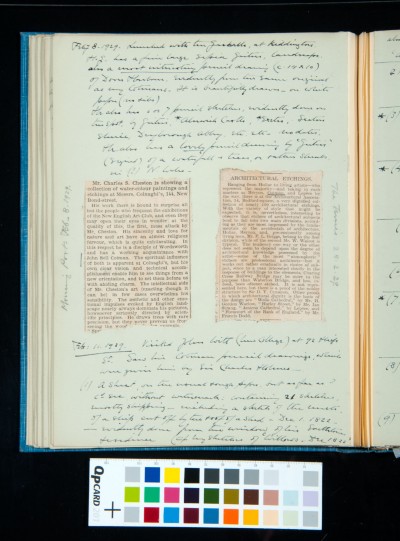Cotmania. Vol. III. 1928-9
Archive: SDK Sydney Decimus Kitson Archive
Reference Number: SDK/1/2/1/3
Page: 16 verso
-
Description
Kitson's account of meeting with H. Gaskell and looking at his Girton
Newspaper clipping about an exhibition of Cheston's work
Newspaper clipping about an exhibition of architectural etchings
Kitson account of visit to John Witt and look at his collection of CotmansKitson's account of meeting with H. Gaskell and looking at his Girton
Newspaper clipping about an exhibition of Cheston's work
Newspaper clipping about an exhibition of architectural etchings
Kitson account of visit to John Witt and look at his collection of CotmansDate: Feb. 1929
-
Transcription
Feby. 8. 1929. Lunched with the Gaskells, at Kiddington. H. G. has a fine large sepia Girton, landscape. Also a most interesting pencil drawing (c. 14 x 10) of Dorn Harbour. Evidently from the same original as my Cotmans. It is beautifully drawn - on white paper (no ribs).
He also has 6 or 7 pencil sketches evidently done on the spot by Girton. *Alnwick Castle, *Exeter, Sleaton Sluice, Dryborough Abbey, etc. etc. - no dates. He also has a lovely pencil drawing by 'Girton' (signed) of a waterfall + trees, or rather, shrubs in (?) N. Wales.{Newspaper clipping on left}
Morning Post. Feb 8. 1929.
Mr. Charles S. Cheston is showing a collection of water-colour paintings and etchings at Messrs. Colnaghi, 144, New Bond-Street.
His work is bound to surprise all but the people who frequent the exhibitions of the New English Art Club, and even they may open their eyes in wonder at the quality of this, the first, mass attack by Mr Cheston. His sincerity and love for nature and art have an almost religious fervour, which is quite exhilarating. In this respect he is a disciple of Wordsworth and has a working acquaintance with John Sell Cotman. The spiritual influence of both is apparent at Colnaghi's, but his own clear vision and technical accomplishment enable him to see things from a new orientation, and to set them before us with abiding charm. The intellectual side of Mr Cheston's art (exacting though it can be) in a few cases overwhelms his sensibility. The aesthetic and other emotional impulses evoked by English landscape nearly always dominates his pictures, howsoever seriously directed by scientific principles. He draws trees with rare precision, but they never prevent us from seeing the wood.{Newspaper clipping on right}
The Times. 28[?].2.29
Architectural Etchings
Ranging from Hollar to living artists - who represent the majority -and taking in such masters as Meryon, Cotman, and Lepere by the way, there is a the Architectural Association, 34, Bedford-Square, a very dignified collection of nearly 100 architectural etchings. With the variety of styles that might be expected, it is nevertheless interesting to observe that etchers of of architectural subjects tend to fall into two main divisions, according as they are most impressed by the fundamentals or accidentals of architecture. Hollar, Meryon, and, pre-eminently among living men, Mr F L Grigg's belong to the first division, while of the second Mr W Walcot is typical. The tendency one way or the other does not seem to depend upon the degree of architectural knowledge possessed by the artist - some of the most "atmospheric" etchers are professional architects - but it works rather erratically in choice of subjects, since to a man interested chiefly in the response of buildings to the elements, Charing Cross Railway Bridge may be more to the purpose than Waterloo Bridge, and has, indeed, been oftener etched. It is not represented here, but there is proof of the nobler structure by Sir D. Y. Cameron. Other proofs in which architectural dignity is the basis of design are "Wells Cathedral" by Mr H. Gordon Warlow, "Harley Street" by Mr Ian Strang, "Amiens Cathedral" by Lepère, and "Forecourt of the Bank of England" by Mr Francis Dodd.{Kitson's diary}
Feb: 11.1929.
Visited John Witt (New College) at 92 High Street. Saw his Cotman pencil drawings, which were given him by Sir Charles Holmes.
(1) A sheet, on the usual rough paper, but as far as I could see, without watermark: containing 21 sketches, mostly shipping - including a sketch of a ship cut off by the roof of a shed - Dec. 1 1822. evidently done from the window of his Southtown residence (cf. my sketches of 'Willows, Dec. 1822'.)
